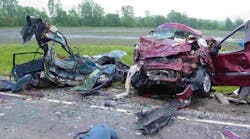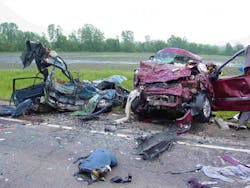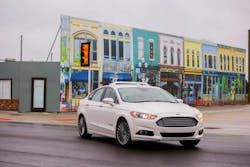The rapid and ongoing spike in highway fatalities over the last year – jumping up 9.3% during the first nine months of 2015 alone; some 26,000 deaths compared to 23,796 fatalities over the first nine months of 2014 – seems to be behind the intensifying effort within the U.S. Department of Transportation (DOT) as a whole and the National Highway Traffic Safety Administration (NHTSA) in particular to make self-driving vehicles a reality.
Indeed, NHTSA’s been holding a series of “regional summits” since February across the U.S. (they completed the last of them just last week) to highlight in part that “human factors” contribute to 94% of vehicle crashes.
On a year-over-year basis the numbers are even starker. Preliminary estimates from the National Safety Council (NSC), for one, indicate motor vehicle deaths were 8% higher for the year in 2015 than they were in 2014 – the largest year-over-year percentage increase in 50 years.NSC estimates 38,300 people were killed on U.S. roads, and 4.4 million were seriously injured, meaning 2015 likely was the deadliest driving year since 2008.
Over the last year at the state level, the NSC estimates Oregon (27%), Georgia (22%), Florida (18%), and South Carolina (16%) all experienced increases in fatalities, while only 13 states showed improvement, among them, New Mexico ( down 20%), Kansas ( down 7%) and New Jersey (down 2%).
So, since humans seem to be the culprit behind the majority of vehicle crashes … why not remove them from the equation? At least, that’s how the thinking seems to going on this issue, from what I can tell.
“We are witnessing a revolution in auto technology that has the potential to save thousands of lives,” noted Transportation Secretary Anthony Foxx in a speech last week. “In order to achieve that potential, we need to establish guidelines for manufacturers that clearly outline how we expect automated vehicles to function – not only safely, but more safely – on our roads.”
Those “guidelines” are one of five NHTSA initiatives Foxx announced in January that seek to speed up the deployment of autonomous vehicle (AV ) systems. The other four are:
- A proposal to spend $3.9 billion in federal funds over the next 10 years to spur AV technology initiatives – including large-scale “deployment pilots” of AVs across the country.
- Developing “model state policy” initiatives that would allow AVs to operate on U.S. roads;
- Using NHTSA’s existing authority to interpret current regulations, and offer limited exemptions from those regulations, in pursuit of advances that could increase safety.
- Determining what new regulatory tools and authorities might be required to meet NHTSA’s safety mission in an era of rapidly changing technology.
“The Volpe Center report is a great first look at the current standards,” noted NHTSA Administrator Mark Rosekind in a statement. “It also shows there are few current restrictions on some automated vehicle concepts, which highlights the need to establish clear expectations for their safe operation. At the same time, for other vehicle designs, the agency has more work to do to ensure the safety of new innovations.”
Rosekind added that the fatality means “we’re seeing red flags across the U.S.,” meaning its “time to drive behavioral changes in traffic safety and that means taking on new initiatives [while] addressing persistent issues like drunk driving and failure to wear seat belts.”
NHTSA plans to hold its first public meeting on April 8 to discuss self-driving cars and their potential safety benefits at DOT’s main headquarters in Washington, D.C., with a follow up meeting out in California later on.
Will this light a fire under the already-burgeoning effort to bring self-driving vehicle technology en masse to our highways? We’ll see.





